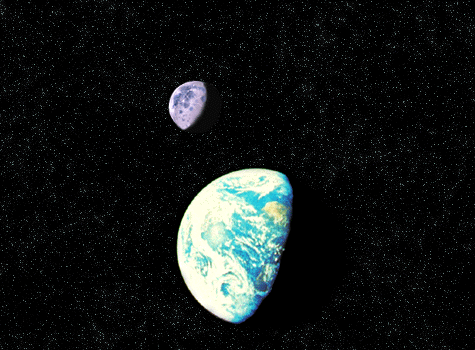

The earth has a bulk density of 5.5 grams per cubic centimeter. This
density reflects the composition of material at the location in
the solar system where the Earth was assembled via accretion. Logically
one would therefore expect the moon to the have the same density.
However,the moon has a density of 3.3 grams per cubic centimeter. Is this a problem?
The Origin of the Moon:
Until recently, the origin of the Moon was not understood.
The moon has long been
an anomaly because its mass is 1/80th of Earth's mass and volume is 1/50th of Earth's volume. This is very large for a
planetary satellite. For instance, the moon to planet mass ratio for Ganymede,
the largest moon in the Solar System, to it's planet Jupiter is less
than 1/1000th. Their volume ratio is almost 1 to 20,000.
Possibilities for Lunar Origin:
The above 3 scenarios for lunar formation are all physically
implausible so why is the moon there?
Let's imagine the following sequence:
Here is the Sequence if there was an impact
The problem with this scenario is that the probability of a direct
collision is small. However, the same result can occur if there is
not a direct collision but instead there is a close passage by the
Mars sizes object.
Here is the Sequence if it was a close passage:
Since the moon formed from the condensation of a debris ring in
relatively near-earth orbit, the moon was initially quite close
to the earth. At this time (4.6 billion years ago) the earth
was rotating quite rapidly (about once every 5 hours). The nearby
moon exerted large tidal forces on the spinning earth causing
it to slow down. This process continues to day. To conserve
total system angular momentum, the response of the moon is then
to move farther away from the earth.
 Yes! This implies
a special formation history for the Moon which is difficult to understand
from first principles.
Yes! This implies
a special formation history for the Moon which is difficult to understand
from first principles.
 NO! its composition/density is
wrong
NO! its composition/density is
wrong
 Implies formation near Mars
Implies formation near Mars  how did it get here?
how did it get here?

Step 1: The Mars planetisimal is poised to strike the molten protoplanet
earth which has been differentiated.

Step 2: The impact into the molten earth sends large molten lumps of debris out of the earth - mostly from the middle layers of the differeniated earth.

Step 3: The debris ring of molten ejecta coalesces, by accretion, into a single object. The density of that object
would be similar to the density of the middle layers of the earth (e.g.
about 3.5 grams/cc). In computer numerical models, this coalescence occurs fast, on a timescale of about 100 million years.

This shows the encounter path.

Step 1: A tidal force is exerted on the molten earth which causes an obvious
deformation.

Step 2: The deformation actually
separates from the earth initially as a whole molten blob whose composition
again reflects the middle layers of the Earth

Step 3: However, this
molten blob is gravitationally perturbed by the combined forces of the
Earth and the still near Mars size object so it distengrates into
a debris ring.

After a 100 million years or
so, the debris ring has coalesced into the moon, and the Earth has cooled
so that water vapor in its atmosphere (combined with bombardment by
comets) has produced the oceans.